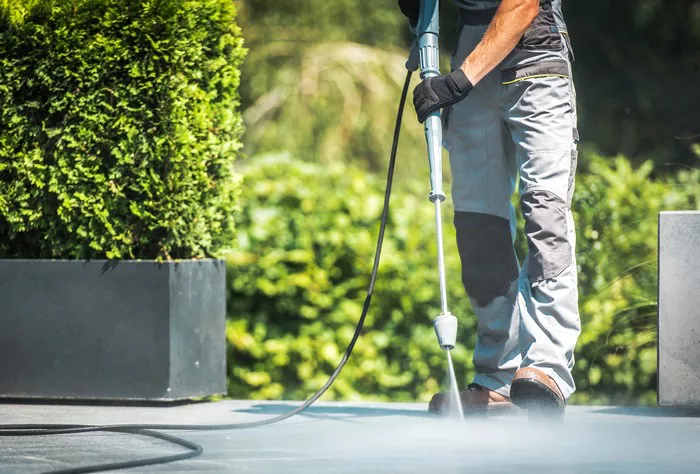Using pressure washing techniques may be a very successful way to clean concrete surfaces. To get the best results without causing harm, it is essential to determine the right PSI (pounds per square inch) for the task. We will examine the variables that affect PSI selection, provide suggestions for different concrete cleaning jobs, and provide advice on safe and effective pressure washing techniques in this extensive book.
Understanding PSI and Its Significance
The pressure that a pressure washer’s water stream applies to a surface is measured in PSI. It is one of the most important factors to take into account while doing pressure washing jobs. The force with which water is forced to the surface is determined by the PSI rating, which also has an effect on the cleaning ability and possible effects on certain materials.
Factors Influencing PSI Selection
Several factors influence the selection of PSI for washing concrete surfaces:
1. Type of Concrete: Different types of concrete vary in hardness and durability. For instance, residential driveways typically consist of standard concrete, while industrial floors may be made of reinforced or stamped concrete. The PSI requirement will depend on the specific characteristics of the concrete being cleaned.
2. Level of Dirt and Stains: The extent of dirt buildup, stains, and contaminants on the concrete surface will influence the necessary PSI. Stubborn stains such as oil, grease, or mold may require higher pressure to effectively remove them.
3. Surface Condition: The condition of the concrete surface, including cracks, pits, or surface imperfections, will impact the PSI selection. Higher PSI may exacerbate existing damage or cause new ones, so it’s essential to assess the surface carefully before determining the pressure level.
4. Water Flow Rate: In addition to PSI, the water flow rate, measured in gallons per minute (GPM), plays a crucial role in cleaning efficiency. Higher flow rates can help flush away loosened debris more effectively.
5. Type of Equipment: The type and quality of pressure washing equipment used also influence PSI selection. Commercial-grade pressure washers typically offer a wider range of PSI settings and may be better suited for demanding cleaning tasks.
Recommended PSI for Common Concrete Cleaning Tasks
To assist you in selecting the appropriate PSI for various concrete cleaning tasks, consider the following recommendations:
1. Routine Maintenance Cleaning (Sidewalks, Patios, and Driveways): For routine cleaning of lightly soiled concrete surfaces, a PSI range of 1,500 to 2,500 is generally sufficient. This level of pressure effectively removes dirt, dust, and mild stains without risking damage to the concrete.
2. Heavy-Duty Stain Removal (Oil Stains, Grease, and Mold): Stubborn stains and contaminants may require higher PSI settings ranging from 2,500 to 3,500 or more. However, caution must be exercised to avoid causing surface etching or other damage, particularly on older or weathered concrete.
3. Preparing Concrete for Sealing or Coating: Before applying sealants or coatings to concrete surfaces, thorough cleaning is essential to ensure proper adhesion. A PSI range of 2,000 to 3,000 is typically recommended for this preparatory step, effectively removing dirt, grime, and previous coatings without compromising the surface integrity.
4. Industrial and Commercial Cleaning: In industrial settings or areas with heavy foot or vehicle traffic, higher PSI levels may be necessary to tackle deep-seated stains and contaminants. Pressure washers with PSI ratings exceeding 3,500 are commonly used for these demanding applications, but professional expertise is advised to avoid causing damage.
Tips for Safe and Efficient Pressure Washing
To achieve optimal results while minimizing the risk of damage to concrete surfaces, adhere to the following guidelines:
1. Start with Low Pressure: Begin with the lowest PSI setting and gradually increase the pressure as needed while monitoring the surface reaction. This approach helps prevent unnecessary damage and allows for precise adjustment based on the cleaning requirements.
2. Maintain a Safe Distance: Maintain a distance of 6 to 12 inches between the pressure washer nozzle and the concrete surface. Holding the nozzle too close can result in etching or gouging, while holding it too far may reduce cleaning effectiveness.
3. Use Proper Nozzle Attachments: Select the appropriate nozzle attachment based on the cleaning task and desired pressure level. Wide-angle nozzles are suitable for low-pressure rinsing, while narrow-angle nozzles provide higher pressure for stain removal.
4. Apply Cleaning Solutions Wisely: For tough stains and contaminants, pre-treating the surface with a suitable cleaning solution can enhance the effectiveness of pressure washing. Ensure proper dilution and application according to the manufacturer’s instructions.
5. Exercise Caution around Edges and Joints: Exercise caution when pressure washing near edges, joints, and delicate surfaces such as caulking or sealant. Lower the pressure or use a wider nozzle to avoid damaging these vulnerable areas.
6. Perform Test Patches: Before proceeding with full-scale cleaning, conduct test patches on inconspicuous areas to assess the impact of pressure and ensure compatibility with the surface.
7. Protect Surrounding Areas: Shield nearby vegetation, outdoor furniture, and sensitive surfaces from overspray and potential damage by covering them with plastic sheeting or tarps.
8. Follow Safety Precautions: Wear appropriate personal protective equipment (PPE), including safety goggles, gloves, and non-slip footwear, to protect against debris and chemical exposure. Additionally, exercise caution when operating pressure washing equipment to avoid accidents or injuries.
Conclusion
For concrete surfaces to be cleaned effectively and the material’s structural integrity to be maintained, the right PSI must be chosen. You can choose the right amount of pressure for any cleaning work by taking into account variables including the kind of surface, the amount of filth and stains present, and the capabilities of your equipment. Additionally, a safe and effective pressure washing experience is guaranteed by adhering to best practices and advised safety procedures. By following the advice in this article, you may confidently take on concrete cleaning chores with care and accuracy, preserving the longevity and visual attractiveness of your outdoor surfaces.

